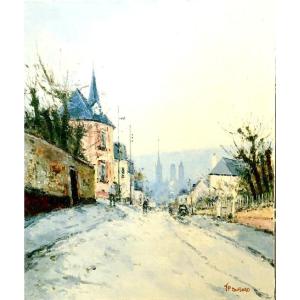Study trips
From Paris, Paul Hoeniger also undertook various study trips to other cities, including Belgium and the Netherlands, where he studied the works of deceased and current artists, following the similar trips of his teacher Franz Skarbina.
Painter of everyday scenes.
After his return to Germany, he lived at 41 Reine Augustastrasse in Berlin, in the same house as his teacher Franz Skarbina.[4] As he had learned in Paris, he mainly painted scenes from everyday life and became known as a specialist in this genre. Gerhard Strauss even described him as "a forgotten painter of Berlin and its working class".[5] Some of Hoeniger's early drawings, e.g. B. the graphics Early Morning to Work, Berliner Dienstmann, Berlin O. and In the Yarn Dyeing Factory can support this judgment. Through his choice of subjects, Paul Hoeniger clearly distinguished himself from other painters of the time who preferred historical-heroic or military-political themes and were thus able to gain the attention and approval of official bodies.
Exhibition activity
Since 1888 he has participated in the exhibitions of the Berlin Academy of Arts, where his painting In Café Josty attracted attention, as well as in the Great Berlin Art Exhibition. At the first exhibition of the Berlin Secession in 1899 he showed his painting Old Berlin.[6]
At the second exhibition of the Berlin Secession in 1900 he showed the oil paintings An Old Corner and Stop (Fog Mood).[7] From 1900 Hoeniger was listed as a full member of the Berlin Secession. Between 1891 and 1912, he regularly participated in exhibitions in Germany (Glass Palace in Munich), but also participated in exhibitions in Paris, notably at the Salons of 1895, 1898 and 1904.
Works (selection)
At the Café Josty (1890)
Boy standing at the kitchen door (1892)
Mesdames de Paris (1897)
Moulin de la Galette, Paris Old Berlin (1899)
At the Belle Alliance bridge An old angle (1900)
Stop (foggy mood) (1900)
A woman and a child on a forest path, 1900
On the beach of Westerland, Sylt (1900-1910)
Early morning to work (drawing, 1901)
Berlin servant (drawing, 1901)
Art Nouveau lady (1903)
Bridge over Baumwall, Hamburg (1905)
Meadow with trees Vegetable market in Dieppe The Church of Saint-Jacques in Dieppe Old House in Dieppe (also: The Red House) (1909)
At the Cathedral (Dieppe) (1909)
The Villa Goldschmit
Lively Market in Front of the Michaelis Church in Hamburg
Market in Hamburg (Rödingsmarkt)
The Church of Moret-sur-Loiny Immersed in Love (drawing)
The Old Alexanderplatz in Berlin
View of Palazzo Dario in Campiello Barbaro in Venice (1911)
Village Alley (1912)
Spittel Market (1912)
River Landscape In the Castle Garden Autumn Days in Paris
Village Street on a Cloudy Day On the Beach (1921)
Beach Scene with Bathers (1923)
Portrait of a Lady (1924)








































 Le Magazine de PROANTIC
Le Magazine de PROANTIC TRÉSORS Magazine
TRÉSORS Magazine Rivista Artiquariato
Rivista Artiquariato